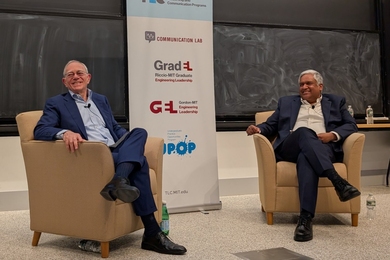Many workplaces feature major changes in occupancy over the course of a week. In academic buildings, hundreds of students may pour in for a lecture, then leave an hour or two later, while faculty, researchers and staff can enter and exit in irregular patterns. In commercial structures, workers may come and go en masse during short time periods during the day. As a result, energy use in virtually all workspaces can rapidly become inefficient — too large or too small — in relation to the number of people inside.
Now, a new study done on MIT buildings reveals some data that could help designers and building managers, on campuses or in the commercial sector, optimize energy usage — and suggests a template for conducting more research on the subject.
The study, published in the April issue of the journal Energy and Buildings, examines data from MIT’s buildings 37 and E52, and finds that while electricity use corresponds to occupancy fairly well in those spaces, the activity of heating, ventilation and air conditioning (HVAC) systems in the buildings does not correlate closely to occupancy.
“It can take a huge amount of energy to heat up buildings during the day, and then suddenly there may be nobody there,” says co-author Carlo Ratti, director of the Senseable City Laboratory and associate professor of the practice in MIT’s Department of Urban Studies and Planning (DUSP). “There is significant potential for improvement and savings, if you could get a more dynamic usage of energy in this area.”
As Ratti and the co-authors note, the federal government estimates that commercial buildings account for about 20 percent of U.S. energy consumption, and 12 percent of U.S. contributions to greenhouse gas emissions; past studies have shown that commercial buildings could reduce their energy use 20 to 30 percent by implementing strategies that better match energy use and need.
An energy disconnect
The new study uses data about Wi-Fi connections as a proxy for building occupancy, a method the researchers believe could be replicated elsewhere at low cost; while the data does not necessarily reveal an exact population count inside buildings, it does indicate relative occupancy levels over time. “It’s a way of trying to make use of information that already exists,” Ratti says.
The researchers analyzed two very different kinds of buildings. Building 37 at MIT — the Ronald M. McNair Building, named for the late astronaut and alumnus (PhD ’77) — houses researchers in astrophysics, aeronautics and astronautics in a combination of offices, classrooms and labs. By contrast, Building E52, the longtime home of MIT’s Department of Economics, is an Art Deco box standing alone on Memorial Drive by the Charles River, with a sizable entrance atrium and a large number of offices inside.
Analyzing data from all four seasons of 2006, the researchers found that Building E52 has lower levels of energy use, and that both buildings have a distinctive cyclical “signature” of electricity usage that rises and falls daily. Both buildings use more steam (for heat) in winter and spring, and more chilled water (for air conditioning) in summer and fall. But while about two-thirds of the variation in electricity levels can be accounted for by changing occupancy levels, the use of the HVAC systems correlated only weakly to occupancy.
In short, these MIT buildings tended to be heated or cooled over extended periods of time according to season, but not in a way that optimized the use of energy. “We were not surprised to see this disconnect, but it was good to be able to quantify it,” says Prudence Robinson, a researcher in the Senseable City Lab and a co-author of the paper.
In addition to Ratti, the co-authors of the new paper — titled “ENERNET: Studying the dynamic relationship between building occupancy and energy consumption” — are David Lee, an MIT PhD student in DUSP; Claudio Martani, a former visiting PhD student in DUSP from the Politecnico di Milano in Italy; Rex Britter, an engineer specializing in fluid dynamics who is currently a research scientist in the Senseable City Lab; and Robinson.
Experts on energy use in the workplace say the paper deals with a significant issue in their field. “This paper is very much in harmony with our recent efforts to design and modify building infrastructure and systems to match varying occupancies,” says Jay Phillips, senior director of operations for Harvard University’s Faculty of Arts and Sciences, who was not involved in this study. He adds: “There is no question that matching building and equipment schedules with dynamic occupancy patterns is a significant conservation opportunity.”
‘You want to have a better match’
Part of the “disconnect” between occupancy and energy use, the researchers acknowledge, may derive from the special needs of academic buildings, which often house labs with around-the-clock heating or refrigeration demands.
M37 has some spaces like this, although E52 does not. Either way, though, the nuances of academic buildings make them “an ideal test bed” for thinking about ways of saving energy, according to Britter. Suppose a building’s largest room is a lecture hall that is only used for an hour or two a day, but in winter demands a significant amount of energy in order to become warm. One possible way of using energy more efficiently would be to surround the lecture hall with heavily used offices, which can then receive the heat seeping out of the larger space.
In such cases, Britter says, “you’ve got to think through the best way of having a fairly complicated arrangement of offices, so that heat could be distributed from the lecture hall to more rooms.”
There are many possible architectural or engineering solutions to this issue, Ratti notes. The larger point, he says, is that “you want to have a better match. You can move the people to the energy, in which case the architecture can help a lot, or you can move the energy to the people, which is more futuristic.” New sensing-based thermostats, for instance, could regulate temperatures on a more granular basis within buildings, according to the distribution of people within them.
Alternately, Ratti adds, existing spaces can be used for new purposes — such as a once rarely used large common area in MIT’s Building 9, which now houses its Steam Café, and thus has chairs and tables occupied throughout the day. “That’s a much more intensive and better use of the space, with the same embedded energy cost,” Ratti says.
Ratti and the Senseable City researchers are currently pursuing several other studies that use IT data to track the flow of people in urban areas, and say they would like to continue to analyze energy use as part of their ongoing work.
New study of MIT buildings suggests additional approaches to energy efficiency.
Publication Date:

Caption:
MIT researchers have found that energy use does not always correspond to occupancy in the Institute's Sloan Building (E52, top) and the Ronald M. McNair Building (37, bottom)
Credits:
Images: Google SketchUp

Credits:
Image: Google SketchUp





